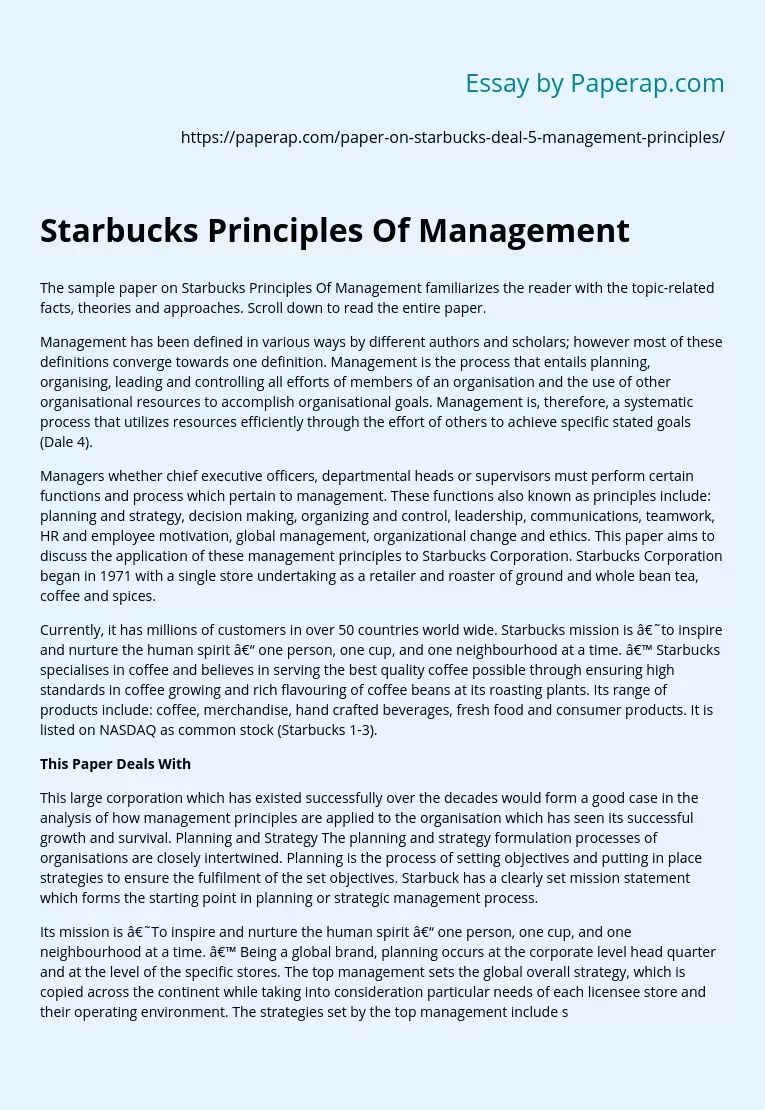Starbucks Principles Of Management
The sample paper on Starbucks Principles Of Management familiarizes the reader with the topic-related facts, theories and approaches. Scroll down to read the entire paper.
Management has been defined in various ways by different authors and scholars; however most of these definitions converge towards one definition. Management is the process that entails planning, organising, leading and controlling all efforts of members of an organisation and the use of other organisational resources to accomplish organisational goals. Management is, therefore, a systematic process that utilizes resources efficiently through the effort of others to achieve specific stated goals (Dale 4).
Managers whether chief executive officers, departmental heads or supervisors must perform certain functions and process which pertain to management. These functions also known as principles include: planning and strategy, decision making, organizing and control, leadership, communications, teamwork, HR and employee motivation, global management, organizational change and ethics. This paper aims to discuss the application of these management principles to Starbucks Corporation. Starbucks Corporation began in 1971 with a single store undertaking as a retailer and roaster of ground and whole bean tea, coffee and spices.
Currently, it has millions of customers in over 50 countries world wide. Starbucks mission is ‘to inspire and nurture the human spirit – one person, one cup, and one neighbourhood at a time. ’ Starbucks specialises in coffee and believes in serving the best quality coffee possible through ensuring high standards in coffee growing and rich flavouring of coffee beans at its roasting plants. Its range of products include: coffee, merchandise, hand crafted beverages, fresh food and consumer products.
It is listed on NASDAQ as common stock (Starbucks 1-3).
This Paper Deals With
This large corporation which has existed successfully over the decades would form a good case in the analysis of how management principles are applied to the organisation which has seen its successful growth and survival. Planning and Strategy The planning and strategy formulation processes of organisations are closely intertwined. Planning is the process of setting objectives and putting in place strategies to ensure the fulfilment of the set objectives. Starbuck has a clearly set mission statement which forms the starting point in planning or strategic management process.
Its mission is ‘To inspire and nurture the human spirit – one person, one cup, and one neighbourhood at a time. ’ Being a global brand, planning occurs at the corporate level head quarter and at the level of the specific stores. The top management sets the global overall strategy, which is copied across the continent while taking into consideration particular needs of each licensee store and their operating environment. The strategies set by the top management include site selection, design and creative concepts for their global stores.
Organization and Control Managerial organization is the process of grouping organisational activities and forming the relationships of authority among them (Kuttyta par. 3). Starbucks is organised by having a top management then managers of various business units like Digital ventures. The top management whose chair is the Chief executive officer (the company president) is the ultimate authority. There are two managers after the CEO one responsible for Starbucks US and the other responsible for Starbucks Coffee International.
The main functions of Starbucks stores are managed centrally for all its global outlets. The management consists of a global: marketing manager, supply chain manager, human resources manager, administrative and finance manager and public affairs manager. These managers liaise directly with regional store managers. Its global presence makes it almost impossible for employees to interact personally with the senior managers (Starbucks). Control on the other hand entails process and practices that managers use to ensure that performance is congruent with before stated plans (Kuttyta pars 4).
The main control mechanisms at Starbucks are governance principles, committee policies and charters that guide decisions made in the organisation. Performance reviews done on all stores and regions also ensure compliance to strategic objectives. Human Resources and Employee Motivation Human resources and employee motivation involves the decisions and activities that enable an organisation to attract and retain qualified personnel in the organisation. These activities include selection, training, development, compensation and appraisal (Duening and Ivancevich 5).
To begin with, in 2009 Starbucks was ranked among the 100 Best Companies to work for by Fortune. Employees are highly valued and as known as partners due to the open and direct relationships with them and Starbucks. Partners are offered comprehensive benefits such as health care benefits and flexible working hours. The optimal scheduling program implemented in 2008 allows partners to work for regular schedules and more hours. Additional benefits include savings plan and stock purchase plan. The selection process is open and acknowledges workforce diversity.
The most qualified people are hired in an open process that allows competitive selection. Being an equal opportunity employer Starbucks looks at qualifications regardless of the race, origin, religion, sex, disability, sexual orientation, gender identity and marital status. The same policy applies to transfers, compensation, promotion and termination benefits. Team work is an essential part of employee motivation as well as an element of organisation. Team work satisfies the employee’s need of wanting to belong to a group or a team, on the other hand it promotes good decision making in an organisation.
At Starbucks team works is applies from top management to employees. Decisions are made and work assignments done in a team to promote the spirit of community and team work which is a core value of Starbuck. Leadership Leadership is a means of inspiring organisational members to achieve organisational goals, because the leader makes the members believe in what they are doing. The style of leadership in an organisation is a determinant of staff morale and is key to effective communication (Wanish pars 3-4).
The managers of Starbuck are transformational leaders who believe in change and in the value of their employees, the reason why they consider their employees partners. The transformational nature of leadership has enabled the organisation to embrace environmental friendly practices like in monitoring their supplier farmers and to be socially responsible for the communities affected by their business. Changes in the organisation originate with the managers who support the change and help their partners to effect change (Starbucks).
Globalization Starbucks has a global presence in over 50 countries. Globalisation has brought a number of challenges to managers; the advances in technology have made it possible even for small firms to compete in the universal arena. Starbucks is a Multinational Corporation having significant operations each of it’s over 50 countries. The need to increase sales drove the company to China with population of 1. 3 billion many of which prefers tea. According to Degree Dictionary (pars1-2), global management is the capacity and business value needed by a multinational to operate effectively and efficiently.
To properly manage its diverse staff, due to its policy of inclusion, equity and accessibility, Starbucks has created global communities and networks which serve the specific needs of its employees (partners). The partner networks help promote inclusion amidst diversity and foster professional and personal development, an example of its partner networks is Starbucks Black Partner Network, whose role is to reinforce connections among the community and assist in the professional development of partners of African descent. Starbucks operates licensing agreements for its global business.
It licenses its brand name, coffee manufacturing technology and trademarks to business in air travel, retail, health care, college/ university, recreation, lodging and healthcare (Starbucks). Starbucks has global operations and products for its licensee stores. The stores have standardized operations worldwide in terms of beverage and food preparation. Decision Making A typical decision making model has six steps: problem definition, objective and criteria setting, generation of alternatives, analysing and selecting the best alternative, planning and implementation of decision and controlling the decision (Lussier 53).
Decisions at Starbucks are made at various level of management. Strategic decisions are made by the top management who in turn allow business unit and operational managers to make decisions for their various units. The governance principles, committee policies and charters dictate that decisions are made after gathering sufficient information and generating alternatives. The policies are a mechanism to ensure decisions are made in the best interest of Starbucks (StarBucks). Ethics
Business ethics are standards of right and wrong that influence behavior. Starbucks is concerned about its ethical behavior and has put in place ethical standards to ensure its compliance with ethics. It has long term relationships with its coffee supplier farmers worldwide to ensure the maintenance of quality and ethical standards in growing and trading by 2015. The ethical philosophy at Starbucks states that, they are aiming for a better cup of coffee which also aids in the creation of a better future for farmers and a more stable climate.
By partnering with Conservation International, Starbuck have been enabled to develop guidelines on ethical sourcing which helps in purchasing coffee that is grown responsibly and traded in an ethical manner. Starbucks works closely with farmers in developing growing methods that are responsible as well as investing in coffee production communities for sustainable supply of coffee. Tea and cocoa sourced by Starbuck is also monitored to ensure ethical standards.
For instance El Triunfo Reserve in Mexico is home to some of the rare bird species in Latin America at the same time the source of coffee for Starbucks. At this forest farmers protect the biodiversity and birds by using traditional shade growing and organic agricultural methods. Further the ethics campaign extends to the procurement of store products such as aprons, shelves and tables. Consideration is given to the manner in which such products are manufactured in comparison to the Supplier Social Responsibility Standards for goods.
Goods and services are procured from suppliers who comply with the ethical standards and who share in Starbucks’ commitment to environmental and social responsibility. Just to show the seriousness of Starbuck to ethics by the end of 2009 they had assessed 114 factories to determine their performance as well as engaging in 37 improvement programs. Starbucks through Starbucks™ Shared Planet™ partners with non-governmental organizations to realise its objectives of community involvement, environmental stewardship and ethical sourcing.
The NGO’s that are associated with Starbucks include: Conservation International, Earthwatch Institute, Fair Trade, United States Green Building Council (USGBC), Sustainable Food Lab, African Wildlife Foundation (AWF), and Business for Social Responsibility (BSR), Ceres, Save the Children, Product (RED) ™, International Youth Foundation (IYF), Ashoka Youth Ventures and Mercy Corps (Starbucks). Starbucks is an organisation with global presence and has embraced the principles of management. The planning and strategy formulation process starts with senior management then tickles down the organisation.
The employees are a valued asset; they enjoy various benefits and their diversity is taken into consideration. The company is organised to have top management and business unit managers that are supported by functional managers based at the head quarters. To ensure that the organization meets its objectives periodic appraisals are carried out as a control mechanism. The transformational leadership at Starbucks has spear headed the inclusion of business ethics and social responsibility among its corporate strategies.
Starbucks Principles Of Management. (2019, Dec 07). Retrieved from https://paperap.com/paper-on-starbucks-deal-5-management-principles/

